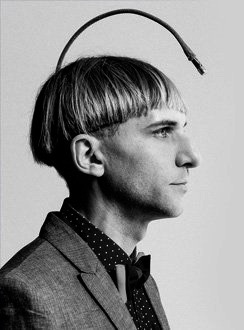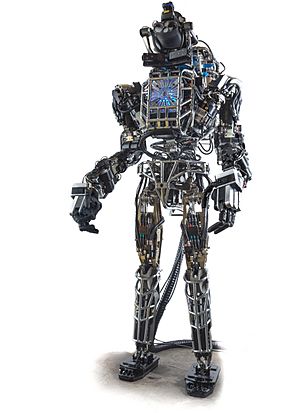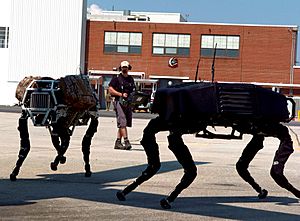Cyborg facts for kids
A cyborg is a living thing that has both natural, organic body parts and artificial, mechanical parts. The word "cyborg" comes from "cybernetic organism." It was first used in 1960 by two scientists, Manfred Clynes and Nathan S. Kline.
A cyborg is different from a regular robot or an android. It's about a living creature that has gained new abilities or had old ones fixed by adding technology to its body. This technology usually works with the body through a "feedback" system, meaning it reacts to what the body is doing. While we often think of cyborgs as humans or other mammals, they could technically be any kind of organism.
In movies and TV shows, cyborgs can look very mechanical, like Cyborg from DC Comics, the Cybermen in Doctor Who, or Darth Vader from Star Wars. Other times, they might look almost exactly like humans, such as the "Human" Cylons in Battlestar Galactica. Often, stories about cyborgs explore ideas about how much we rely on technology, especially for war, and whether technology could take away our free will. Cyborgs in fiction also often have amazing physical or mental powers that are much stronger than a normal human's.
Contents
What Makes Someone a Cyborg?
Some people believe that humans who use even simple technologies are already a bit like cyborgs. For example, if someone has an artificial pacemaker in their heart, they could be seen as a cyborg. A pacemaker is a device that helps the heart beat correctly. It measures the body's electrical signals, processes them, and then sends out its own electrical pulses to keep the person alive. This connection between the body and the machine, where they work together, is a key part of what makes something a cyborg.
Where Did the Idea Come From?
The idea of mixing humans and machines was popular in science fiction even before World War II. However, the actual word "cyborg" was created in 1960 by Manfred Clynes and Nathan S. Kline. They thought of cyborgs as enhanced human beings who could survive in tough places, like on other planets.
Their idea came from thinking about how humans and machines would need to work very closely together as space exploration was just beginning. They imagined a future where technology could help humans live in environments far beyond Earth.
Real-Life Cyborgs

Today, we have many real-life examples of technology helping people in ways that are similar to cyborgs. For instance, the C-Leg system is an advanced artificial leg used by people who have lost a leg. This prosthetic leg has sensors that help it move more naturally, almost like a real leg. Other advanced prosthetics, like the iLimb, are also seen as early steps toward future cyborg technologies.
Cochlear implants are another example. These devices help people who are deaf to hear by sending sound signals directly to their brain. Similarly, some people have magnetic implants that give them new senses they wouldn't normally have. These technologies can be thought of as creating cyborgs because they add new abilities to the human body.
Since 2004, a British artist named Neil Harbisson has had a special cyborg antenna implanted in his head. This antenna lets him "hear" colors as vibrations in his skull, even colors that humans can't normally see. His antenna was even included in his passport photo, which some say confirms his status as a cyborg. In 2012, Harbisson explained that he felt like a cyborg when his brain and the antenna's software started working as one, giving him an extra sense.
Many people also have tiny microchips injected into their hands. These chips can be used for many things, like swiping cards, opening doors, or even buying things with a simple wave of the hand.
Cyborgs in the Military
Military groups have also looked into using cyborg animals for tactical advantages. The DARPA agency, for example, has shown interest in creating "cyborg insects." They plan to implant tiny sensors into insects while they are still young (in the pupa stage). These insects could then be controlled remotely to fly around, explore areas, or even detect explosives and gases.
DARPA is also working on a neural implant to control the movement of sharks from a distance. Sharks have unique senses that could be used to gather information about enemy ships or underwater explosives.
Scientists have successfully tried using neural implants on cockroaches. They put tiny electrodes on the insects, which could then be controlled remotely by a human. While the results varied, it showed that the cockroaches could be guided by the electrical signals they received. DARPA is funding this research because it could be very useful for military and other purposes.
Researchers hope to develop similar technologies for dragonflies, bees, rats, and pigeons. The goal is for these "cybernetic bugs" to be able to fly a certain distance, be guided by a computer to land precisely, and then stay in place.
Images for kids
-
Cyborg Neil Harbisson with his antenna implant
-
Cyborg artist Moon Ribas, founder of the Cyborg Foundation performing with her seismic sense implant at TED (2016)
See also
 In Spanish: Cíborg para niños
In Spanish: Cíborg para niños








